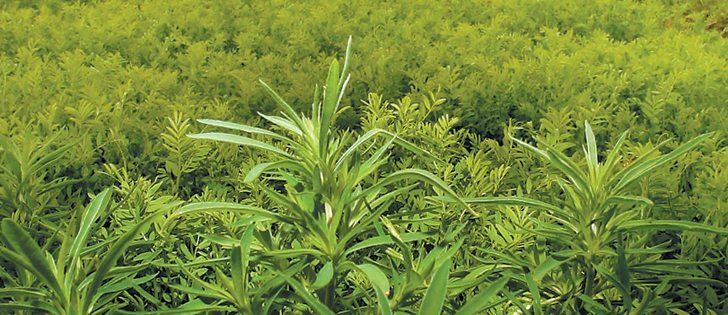Herbicide resistant kochia | Weed can’t be contained but can be slowed with proper control methods
FOREMOST, Alta. — It will be crucial in the coming growing season for western Canadian farmers to manage herbicide resistant kochia before it becomes widespread.
At two March 8 meetings in Milk River, Alta., and Foremost, Alta., near where the first glyphosate resistant kochia was found last fall, researchers told farmers to hit the weed hard and fast to slow weed spread.
It’s not just a southern Alberta problem, said Agriculture Canada weed researchers Bob Blackshaw and Hugh Beckie. Kochia can develop resistance anywhere there is wide use of glyphosate.
Read Also

Manitoba extends Crown land rent freeze
Manitoba government links the continued rental rate freeze on grazing and forage leases to economic and environmental challenges facing the industry
Kochia emerges early in the season, giving farmers an opportunity to kill it with group 4 and 14 herbicides in pre-seeding burn-off.
It also tends to mature late, providing another opportunity for control before it sets seed.
“It’s too late to contain it, certainly,” Beckie told Foremost area farmers.
“The best thing we can do is slow down the rate of spread. There are management options there to control it, but we will need a co-ordinated approach.”
He advocated an “urgent call to action,” which would include notifying farmers, municipalities, railways and oil and gas companies about the problem and the importance of using tank mixes for weed control rather than straight glyphosate.
Glyphosate is widely used in oil and gas sites because it doesn’t persist in the soil. That and the fact that it is relatively inexpensive has increased its use by industrial users as well as farmers, said Blackshaw.
He noted that in fields where the resistant weeds were first found, farmers had used straight glyphosate for their chem-fallow for the last four or five years.
“The worst thing you can do is use glyphosate year after year,” said Beckie.
He encouraged farmers to vary their herbicides from year to year and use tank mixes of chemicals with different modes of action.
Linda Hall, professor and agricultural researcher at the University of Alberta, said surveys have shown kochia is the fourth most abundant weed in this region and is abundant across the Prairies.
It was one of the first weeds to develop Group 2 resistance, and has also become resistant to Group 4 chemicals in the United States. Kochia has a great ability to outcross through pollen and then spread its thousands of seeds when it becomes a tumbleweed at maturity.
“Not only does it matter what happens in your field, but it also matters what happens in your neighbour’s field,” said Hall. “We’re probably not going to be able to stop it.”
However, action early in the growing season will pay dividends, and her research shows most kochia emerges before crops do.
“That gives you an opportunity to control these prior to seeding, with herbicides. If you could get rid of 60 percent of your population before you seed, and then you seed a competitive crop, now you can get the power of the crop working for you.”
Her research also shows that most kochia comes from seed spread in the previous year. It has limited seed dormancy, so controlling it well in one season will limit weed numbers in the following year.
Hall said kochia seed is still green at harvest in southern Alberta in four out of five years, so prevention of seed set by cutting plants or a post-harvest chemical application can help.
After resistant kochia was found in three chem-fallow fields in the Warner, Alta., area last year, Beckie surveyed 50 sites within a 20-kilometre radius of those fields.
“The bad news is, we did find additional sites. We did confirm at least six additional fields with glyphosate resistant kochia.”
Most of the infected fields were to the east or northeast of the initially confirmed fields, reflecting prevailing wind direction.
A wider survey is planned in southern Alberta this year to get a better sense of how widespread the resistant kochia may be, Beckie said. Field trials with herbicides will also be conducted.
Surveys will be done in Saskatchewan and Manitoba next year.
The results, combined with other research, may allow scientists to make recommendations on best management practices for control.
Sean Dilk, technical development manager for Monsanto, said kochia has spread rapidly in Kansas, where the first resistant strain was found in 2007. It is now found throughout western Kansas, eastern Colorado and in Nebraska. There are also suspect cases in North and South Dakota and Montana.
“They (U.S. researchers) said take it seriously and hit it hard. Use all the tools that you have available in your toolbox to stay on top of this weed.”
He reminded farmers to also consider cultural practices for weed control, such as tillage, crop rotation, increased seeding rates and competitive crops.
A website at www.weedtool.com allows farmers to gauge their risk of herbicide resistant weeds.
Beckie and Blackshaw also encouraged farmers to watch their fields for signs of the weed and inform researchers if they suspect herbicide resistance. Monsanto has set up a toll-free line for reports at 800-667-4944.
















